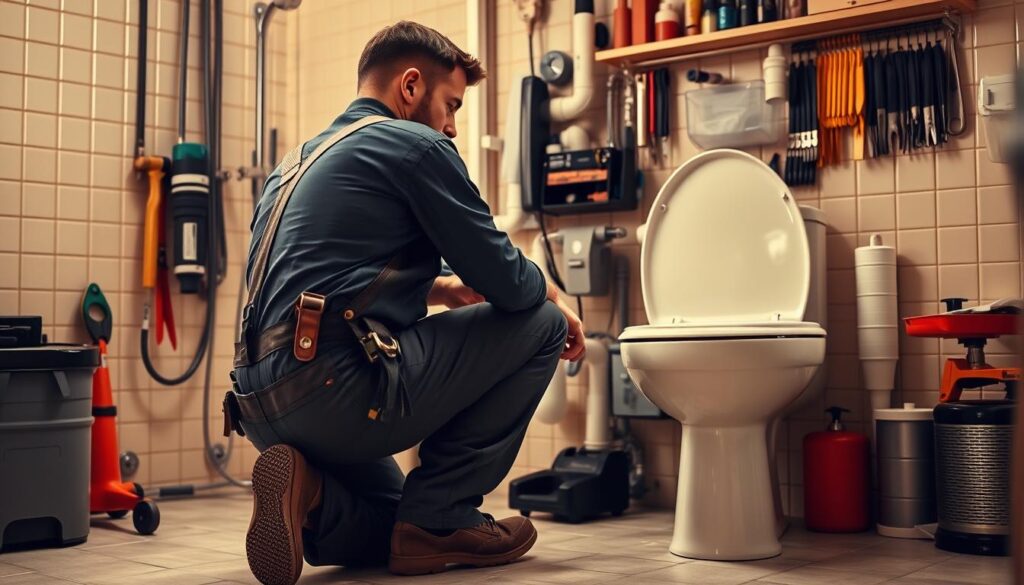
Have you ever wondered whether a stubborn bowl blockage means a simple fix or a major plumbing problem that could ruin your bathroom floor?
We guide North and West Vancouver homeowners and businesses through quick, proven actions. We show when a flange plunger will do the job, how to use dish soap with hot (not boiling) water, and when a baking soda and vinegar reaction can clear a clog.
If water threatens to overflow, shut off the valve behind the unit right away. For diagnostics, pouring two to three gallons of water into the bowl helps pinpoint a bowl-to-pipe clog versus a tank or wider system issue.
We offer rapid local services and clear advice so you can try safe DIY steps or call us for urgent help. For immediate assistance or to book a visit, call 604-670-3737 (6046703737).
Key Takeaways
- Try a flange plunger and steady strokes before calling a pro.
- Hot water plus dish soap or baking soda and vinegar often clear many clogs.
- Shut off the water valve if overflow is likely to prevent damage.
- A simple water-pour test helps diagnose bowl vs. system issues.
- We provide fast, code-conscious plumbing services across North and West Vancouver.
Before you start: diagnose the issue and prevent overflow
Before touching tools, secure the water supply and assess how full the bowl is. Shut the shutoff valve behind the unit at once if the water level rises. If the bowl is very full, remove some water with a cup before any test to stop spills and protect your bathroom floor.
Shut off the water and stabilise the bowl to avoid spills
Close the valve, then steady the fixture so it won’t rock. Lift the tank lid carefully and set it on a flat surface. Wear gloves when handling wastewater and use taped-jaw pliers to protect finishes.
Quick test: pour water to confirm a clog vs. tank or plumbing problem
Pour two to three gallons (7.5–11.5 L) into the toilet bowl. If the water drains within seconds, the trap is likely clear. If it lingers, the blockage is in the trapway or pipe. If the bowl clears but flushing remains inconsistent, the fault may be between the tank and bowl. No flush after clearing points to a wider plumbing problem.
Safety and code considerations for DIY work
Match parts — use the correct flapper size (2″ or 3″) and compatible refill tube and valve. Turn off the water and empty the tank before valve or flush repairs. Avoid overtightening fasteners; porcelain can crack. If overflow is continuous, stop and call us at 604‑670‑3737 to protect floors and save time.
How to unclog a toilet with a plunger the right way
A precise plunging method gives the best chance to clear a stubborn bowl blockage. We recommend a flange plunger because its extended cup seals the trapway better than a flat cup.
Build a proper seal with a flange plunger
If the bowl is near the brim, remove some water first. Seat the rubber cup over the drain and make sure the flange fits into the trap opening for an airtight seal.
Step-by-step plunging technique
Keep enough water in the bowl to cover the plunger cup. Insert the plunger slowly to let air escape the bell.
- Start with gentle strokes to avoid splashing.
- Increase to firm, straight plunges in a steady rhythm for several times.
- Use forceful, but controlled, pushes to move water through the drain and dislodge the clog.
What normal water changes tell you
A successful attempt usually lowers the bowl water level. To confirm, pour about 4 litres slowly — if it drains smoothly, the blockage cleared.
If repeated cycles do not improve drain behaviour, the clog may be deeper. At that point we suggest you call Lord Mechanical LTD at 6046703737 for fast, local help in North and West Vancouver.
| Step | Action | Signal of Success |
|---|---|---|
| Prepare | Remove excess water, don gloves, seat flange plunger | Bowl water covers plunger cup |
| Plunge | Start gentle, then firm straight strokes (several times) | Water level drops; resistance eases |
| Test | Slowly pour ~4 L to confirm drainage | Water drains smoothly; flush restores siphon |
How to unclog without a plunger: proven at‑home methods
“Simple steps often stop a clog before it becomes an emergency.”
You can often free a blocked bowl using controlled, low‑risk kitchen methods. We show two measured approaches, safe temperatures, and clear decision points so you know when to stop and call us.
Dish soap and hot (not boiling) water method
Remove some water so the bowl has room for about 4 litres. Add a generous squirt of dish soap to lubricate the trap.
Heat water until very hot but not boiling — like a hot cup of tea — then pour into the bowl. Wait about 20 minutes before testing the flush. A lower water bowl line usually means progress.
Baking soda and vinegar reaction
Remove at least half the bowl water. Add 250 ml baking soda, then pour 500 ml vinegar. Let the mixture foam vigorously and sit for 20 minutes. Test the flush carefully.
When to try enzymes or a toilet auger
If these methods fail after a few safe attempts, try an enzyme product made for organic clogs or use a toilet auger to break a deep blockage. Close the shutoff valve if the level rises. If results do not improve, call Lord Mechanical LTD at 6046703737 for prompt help in North and West Vancouver.
DIY toilet repairs beyond clogs: quick fixes that work
Many routine faults can be fixed fast with basic parts and a little care. We focus on safe, high‑value steps you can try before calling a pro in North or West Vancouver.

Stopping a constantly running unit
A running unit usually means the flapper is not sealing the flush valve. Inspect the flapper for wear and match the correct 2″ or 3″ size before replacing it.
Also check the refill tube—ensure it rests above the overflow, not inserted into it, to stop ghost flushing.
Fixing leaks: supply, tank-to-bowl, base
Tighten supply line connections and inspect the fill valve base. Replace lines older than five years.
For tank-to-bowl leaks, tighten bolts, replace the gasket, and check for cracks. For floor leaks, examine mounting bolts and the flange; replace the wax ring if needed.
Handle, lift arm, chain tuning
Adjust chain slack so the flapper lifts fully without snagging. Reverse-thread nuts can loosen—check orientation and secure firmly but avoid overtightening.
Slow filling and correct water levels
Open the shutoff fully, clear fill valve debris, or replace the valve using shutoff‑drain‑swap steps. Set the tank water level per manufacturer guidance and aim for about half‑full in the bowl to ensure a strong flush and fewer clogs.
| Issue | Quick fix | When to call |
|---|---|---|
| Constant running | Replace flapper or flush valve; reposition refill tube | Flapper sizes fail or valve body leaks |
| Supply line leak | Tighten fittings; replace old braided line | Persistent drip after tightening |
| Base leak / rocking | Tighten bolts, shim base, replace wax ring if needed | Floor softens or seal fails |
| Slow fill / low pressure | Clear or replace fill valve; open shutoff fully | New valve still slow or noisy |
Regular maintenance—inspect flappers, check water level, and replace worn gaskets—keeps systems reliable. If a fix risks cracking porcelain or causing flood damage, call Lord Mechanical LTD at 604‑670‑3737 for fast, local plumbing help.
When DIY isn’t enough in North Vancouver
Not every blockage is a quick DIY win; some faults signal a systemic plumbing problem. We outline the signs that mean it’s time to stop DIY and call for professional diagnosis.
Signs of deeper issues: clogged vents, persistent overflows, cracks
If the bowl won’t hold water or drains oddly, a blocked vent can siphon the trap. That vent issue requires inspection above the roofline.
Repeated overflow after proper plunging points to a stubborn obstruction or a shared-pipe problem. Visible cracks in the tank or bowl are non-negotiable — cracking mandates replacement.
Protect your floors and subfloors: why timing matters
Base leaks after bolt tightening usually mean a failed wax ring or flange. Continued seepage soaks flooring and invites mould, odours and costly structural work.
- We identify systemic issues when overflows recur despite correct technique.
- We use targeted tools — camera inspection, careful augering and vent checks — to limit disruption.
- Early action prevents escalating damage in multi-storey homes and busy commercial bathrooms.
| Symptom | Likely issue | Professional action |
|---|---|---|
| Persistent overflow | Deep blockage or shared-pipe restriction | Camera inspection, targeted auger |
| Bowl drains mysteriously | Clogged vent | Vent evaluation, roof access cleaning |
| Floor stains under base | Compromised wax ring or flange | Remove fixture, replace ring/flange, inspect subfloor |
If you spot these signs, call us early to protect property value and safety: 6046703737.
Toilet repairs and unclogging services: fast, reliable help
A prompt, professional response keeps small plumbing problems from turning into big, costly ones.
We offer same‑day services across North and West Vancouver. Call 604‑670‑3737 for emergency plumbing — we can usually schedule ASAP.

Emergency plumbing in North Vancouver — call 604‑670‑3737
We arrive prepared to protect your bathroom and contain any water. We quickly determine whether the issue is local to the fixture or in the main drain line.
What to expect from a pro visit: diagnosis to clean, lasting fixes
On arrival we run focused tests to confirm the blockage location. We use covered tools and mats to protect flooring and finishes.
- Clear explanation of the steps, time and likely fixes before work begins.
- Professional augers and diagnostic gear to clear obstructions without harming porcelain.
- Replace worn parts — flappers, fill and flush valves, and refill tube placement — so flushing is reliable.
- Reseat rocking fixtures, install new wax rings, and correct flange issues to stop base leaks.
- Final testing of flush performance, water levels, and a clean work area plus practical tips to avoid repeat situations.
| Service | Action | Outcome |
|---|---|---|
| Diagnosis | Confirm blockage location; camera or water tests | Clear scope of work; accurate time estimate |
| Clearing | Use auger or advanced equipment; protect surfaces | Safe, effective obstruction removal |
| Component repair | Replace flapper, fill/flush valves, adjust refill tube | Quiet, reliable flush and correct water levels |
| Base seal | Reseat fixture, replace wax ring, repair flange | No leaks; stable fixture and protected subfloor |
Need help now? Call Lord Mechanical LTD — your local plumber team in North and West Vancouver at 6046703737. We explain the things we’ll check, the likely steps, and the time needed for each situation.
Conclusion
Finish strong: a clear action plan helps you stop water damage and restore normal flushing fast.
First, diagnose and stop the flow. Close the shutoff if the water level rises, then use a flange plunger to build a tight seal and push the clog free.
If you prefer a non‑plunger method, try dish soap plus about 4 litres of hot (not boiling) water and wait ~20 minutes. A measured baking soda (250 ml) and vinegar (500 ml) mix with a 20‑minute dwell is another gentle option for a clogged toilet.
Check tank parts — correct flapper size, a clean fill valve, proper refill tube position and the right water level prevent repeat problems. If vents, cracks or persistent overflow appear, we will handle the deeper issue.
Need help now? Call Lord Mechanical LTD at 604‑670‑3737 for fast plumbing service across North and West Vancouver.

